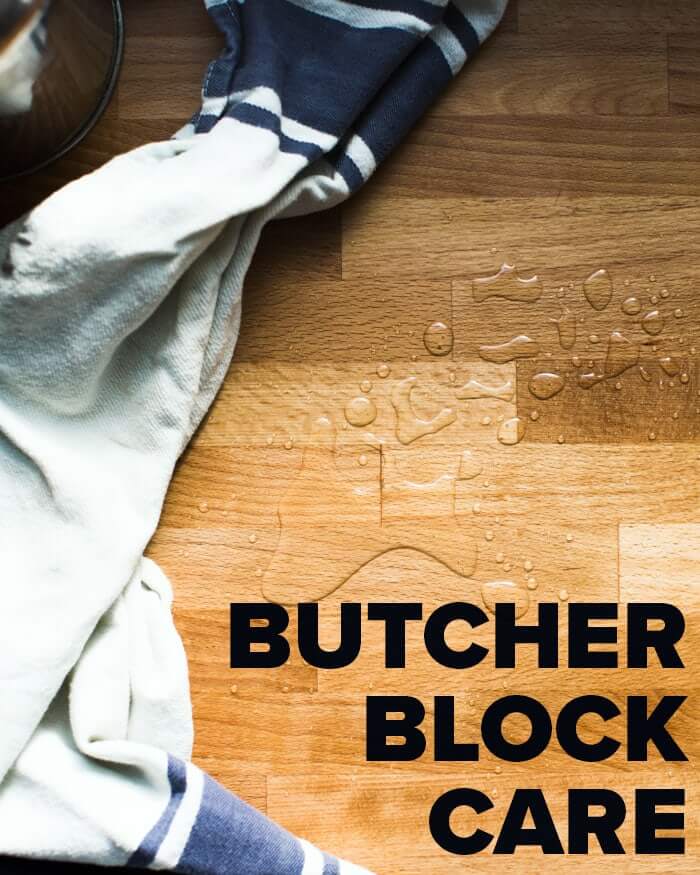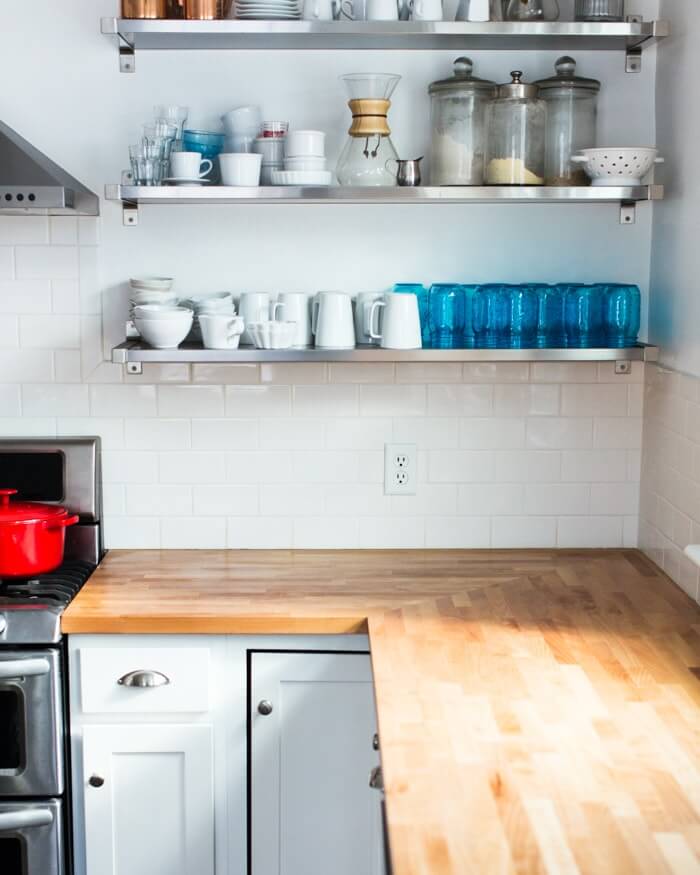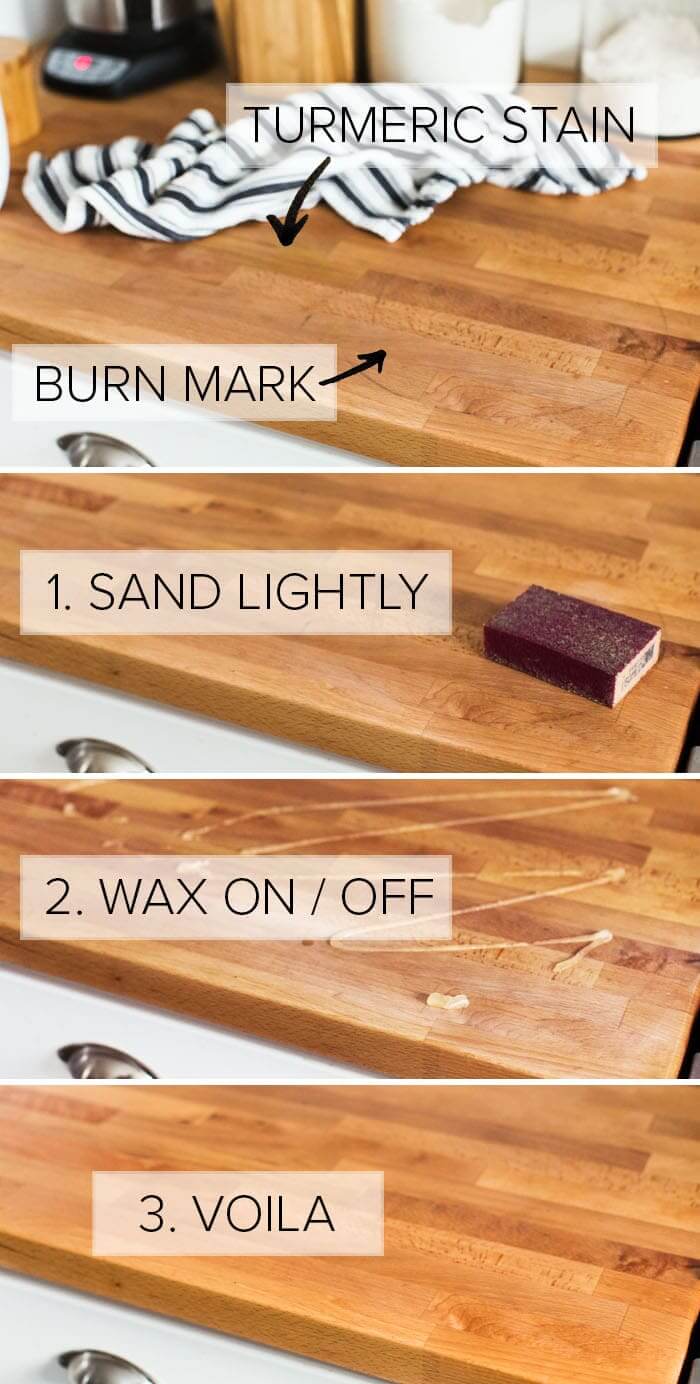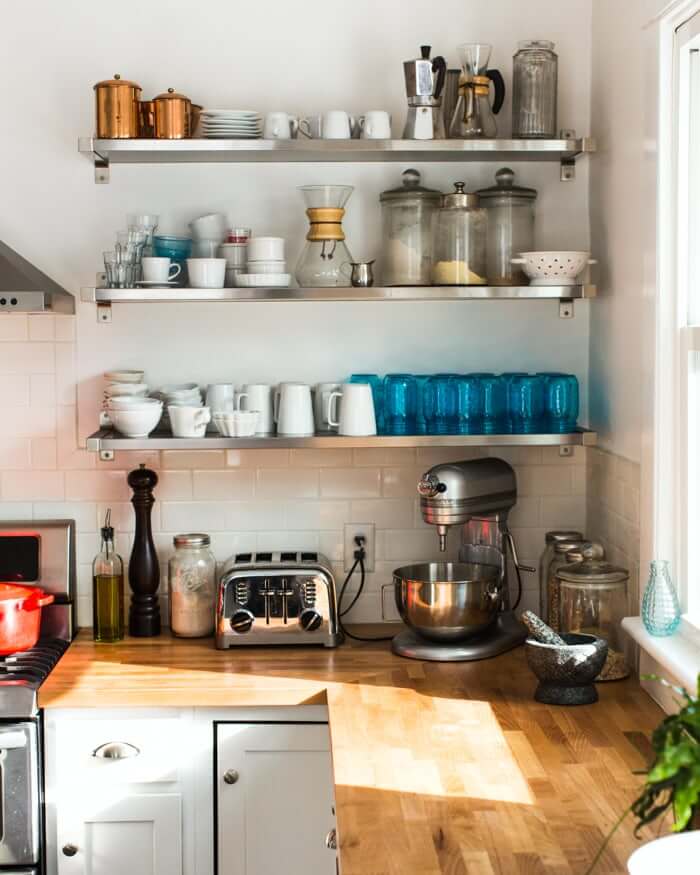This post may include affiliate links; for details, see our disclosure policy.
Step-by-step instructions on how to take care of butcher block countertops added in our kitchen renovation, including sanding and oiling.

If there’s one question we get asked again and again about our kitchen renovation, it’s “how do you like your butcher block countertops?”. It’s an easy answer for us: we love them! They’re affordable, they’re beautiful, and they add a nice warmth to an otherwise bright kitchen. We have the beech counters from IKEA and left them completely unfinished, aside from monthly oiling (details below!). We’ve found the butcher block countertops to hold up quite well to our usual messy selves in the kitchen!
Our Butcher Block: A Few Notes
Two important notes regarding our butcher block counters:
- Our main sink is in a quartz-countertop island, so we do not wash dishes near the butcher block counters. We are always careful to dry off any standing water the butcher block to avoid stains.
- Although we’ve been careful to only use food-safe oils on our otherwise unfinished counters, we do not cut or chop directly on the counters, since we’d like them to stay in great shape as long as possible.
Otherwise, we’re not too timid around the counters. They’ve been stained, burned, and used quite thoroughly for two years, and they look better than ever!

Taking care of the counters is fairly simple. Every four to six weeks when the counters start to look and feel dry, we treat them with a butcher block wax/oil combo. We use a food safe butcher block oil / wax combo and we’ve been pleased with the results; I’ve also read that you can simply use mineral oil.
Butcher Block Countertop Maintenance 101
Here are the steps we use to treat our butcher block countertops:
- Clear the counters of all items and lightly sand them with a medium sandpaper block. If you have any stains, you might need to sand more heavily. Don’t worry if it looks a bit lighter in the stained area after sanding; it will blend in after a month or two. Also, don’t be too fussy about getting every last stain out, since a little patina looks good!
- Wipe off all of the dust with a barely-damp rag.
- Warm the wax bottle under hot water for a few seconds, then squirt a line of wax around the counters. You don’t need to use too much.
- Using a paper towel, spread out the wax evenly on the counters. Let it sit for about 10 minutes until the wood absorbs the wax. If you’ve missed a month or two, you may want to repeat this step.
- Using a fresh paper towel, remove any excess wax. Allow the counters to sit for about another 15 minutes — the wood will continue to absorb the remaining wax.
- That’s it! Your counters should be waterproofed and ready to go. Remember, water is the enemy, so make sure to keep them dry!



Related
We love to provide resources for your kitchen and garden! Here are a few more of our resources:



We’re just about to do a kitchen renovation (our first one!) and I love the look of the wooden countertops, but was worried how they would hold up, so this is so good to know!
This couldn’t have come at a better time – I bought a house with a butcher block countertop on the center island and the previous owners unfortunately cut directly on it. I’ve treated it with mineral oil, that was ok. Then I tried Tung Oil, which is a bit better. But I’m still not thrilled with the look of them with all the cutting damage. A good sanding and some of the product you recommended might be the answer!
I hope it works for you! For one of our tougher stains, I actually used a handheld power sander. Good luck!
Hey guys! We’re considering butcher block counters for our upcoming kitchen reno and were wondering why you chose the waxing/oiling regimen over sealing them?
First, we really like the look of the hand-rubbed oi finish over compared to finished wood. But also, I read some concerns about the whether standard wood finishes were food safe and we decided to play it safe. Hope that helps!
We are planning to buy a house in this year with a butcher block countertop and these tips are gonna help us. :)
Our butcher block countertops desperately need sanding/ oiling due to previous occupants not caring for it and its now has mildew around the sink pretty bad. We plan on sanding and oiling but have been practicing on a freshly sanded butcher block cutting board so we didn’t mess up the counters. We’ve been using Howard’s conditioner but it always has a greasy finish. Will the countertops always be like that too? Even after thoroughly wiping it down with paper towels it still is a little greasy and will show on your hand when you run it across the board. I put more oil on the board just about every time i use it/ wash it bc the water still seems to soak into the board, it doesn’t bead up on the surface after i’ve used it. Any recommendations? I don’t particularly want our countertops greasy all the time!
Hi!
Our countertops remain “greasy” for about an hour after treating and then all of the oil soaks in. I think as long as you’re being careful to wipe off any standing water, you don’t need to worry about treating it every time. I hope that helps!
I have a question. We are installing butcher block counter top to our Island. The wood is unfinished and we are planning to use Howard Butcher Block Conditioner for the top, but what about the bottom and the sides of the butcher block? Do we need to apply the conditioner, or something else, to the bottom of the Butcher block? We will be securing the butcher block to an already existing piece of plywood that is secured already on our island.
Hi! We only finish the outward face portions of our countertop. I think as long as other parts stay dry they will be ok… you may want to ask a professional though!
I had no idea that I can clean a wooden countertop with a wax! I am renovating my kitchen, and new butcher-block countertops are a must! Thanks for the advice! Now I will know how I should take care of them.
What kind of wax do you use?
Grace: here is the link to the wax! https://www.amazon.com/dp/B00KSV38NC/ref=as_li_ss_tl?_encoding=UTF8&psc=1&linkCode=sl1&tag=acoco-20&linkId=c5bb59716353fb177076db2bb588c35e
This is great! We just installed a large island with maple butcher block. We’ve only had it for a few weeks and I’ve used mineral oil and Boos conditioner (mineral oil +. Bees wax) on it a couple times. So then my husband left a super large oozing chunk of meat leftovers on it ALL NiGHT. I tried all the tricks online, lemon/salt, baking soda, vinegar, and it looked slightly better until I re-oiled it a couple hours later. Now that whole area is much darker and looks rather worked over. I’m considering sanding it, but question is: do I have to sand the whole thing then? Or can I just do that spot (it’s pretty big)? Is there a limit on how many sands it can take in its life? Thanks in advance!!!
Hi!
When we’ve had a stain, we’ve sanded the whole counter but with an emphasis on the stained spot. Even if the whole stain doesn’t disappear, we’ve found that it blends in after several months of repeated oiling. Your maple is probably a bit lighter than ours so it might turn out a little different. Good luck!
Thank you! Yes, it’s still pretty light. I’ll try sanding the whole thing with an emphasis on that spot and oil again. Thanks again!
We’re going to remodel our kitchen and install new countertops. I love the look of butcher block but have no time for extra maintenance. Is it necessary to re-oil them monthly or is there a finish that will permanently seal and finish them? Thanks!
Hi! I’m not sure about other finishes, sorry!
Thanks!
You might be thinking about Water Lox you an get on Amazon